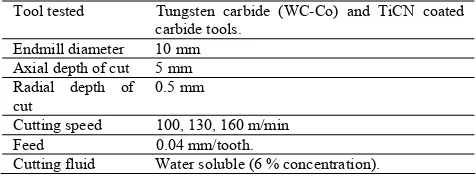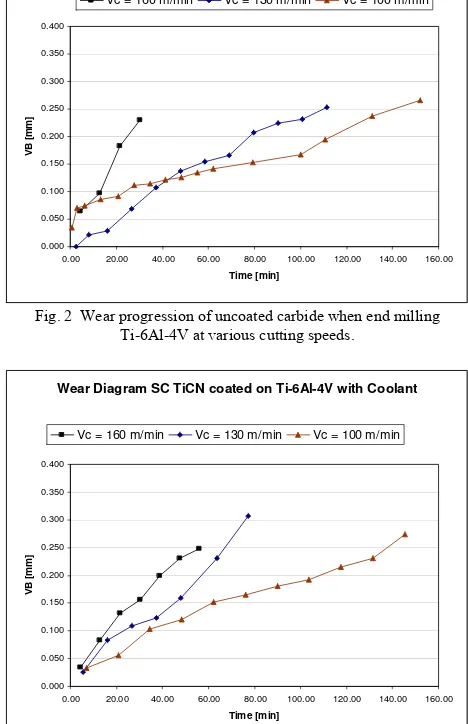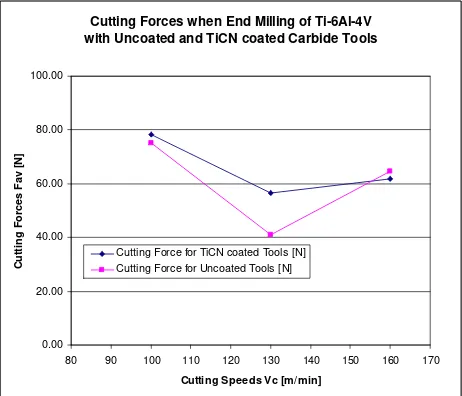Abstract—Cutting performance of uncoated WC/Co
and TiCN coated solid carbide tools when end milling titanium alloy, Ti-6Al-4V was carried out investigated. Tool wear, tool life and cutting forces were investigated during end milling at various cutting speeds. Results showed that uncoated endmill outperformed TiCN coated endmill with regards to tool life at cutting speeds 130 m/min and below. However TiCN coated tools was more superior when endmilling at higher cutting speed. Both tools suffered non-uniform flank wear and chipping at the main cutting edge at most cutting conditions. In general, cutting force was slightly higher when machining with TiCN tool as compared to the uncoated tool. Similar trend of decreasing cutting force with increasing cutting speed was observed on both tools. At higher cutting speed, the effect of TiCN coatings on the cutting force was not significant when the difference in cutting force was very marginal between both tools.
Keywords—Cutting Force, End Milling, Tool Life,
Titanium Alloy, Tool Wear.
I. INTRODUCTION
Progress in the machining of titanium alloys has not kept pace with advances in the machining of other materials. This is due to their high temperature strength, very low thermal conductivity, relatively low modulus of elasticity and high chemical reactivity. Therefore, to be successful in machining of titanium alloys depend largely on the overcoming of the principal problems associated with the inherent properties of these materials [1].
Recently, the developments of cutting tools are incorporated in thin-film production systems, thereby leading to producing of extended variety coatings materials, thus offering coating system selection flexibility according to the requirements of each application. Therefore the coatings can be tailored for specific machining applications and workpiece materials [2]. The majority of carbide cutting tools in use today employ CVD and PVD hard coatings. The high hardness, wear resistance, and chemical stability of these coatings offer proven benefits in term of tool life and machining performance. Chemical vapor deposition (CVD) technologies have advanced from single layer to multi-layer versions combining, TiN, TiCN, TiC and Al2O3. However, over the last decade, physical vapor deposition (PVD) coatings originally limited to TiN, have been successfully applied PVD TiCN and TiAlN to solid round carbide tools and offer performance advantages in applications involving interrupted cutting and those
requiring sharp edges, as well as in finishing and others applications [3].
Most of the machining studies for titanium and its alloys have been focused on the turning process that involves continuous cutting [4][5][6][7][8]. These results are not applicable to drilling process reported in [9][10][11] and also to milling [12][13][14][15] where interrupted cutting takes place, subjecting the tools to a variety of hostile conditions. Severe chipping and flaking of the cutting edge were reported to be the main failure modes when milling titanium alloys with carbide tools. Despite some investigations on milling of titanium alloys, as mentioned before, there are relatively few publications detailing the end milling of titanium alloys. For this purpose Production Laboratory of Universiti Teknologi Malaysia in cooperation with one of Malaysians tools manufacturer (base on the agreement, the name of tool manufacturer is not published) conducted performance evaluation for new developed carbide end mill generation with hard coating TiCN with cutting speeds and feeds commonly used in industry manufacturing.
II. METHODOLOGY
Milling tests were conducted on a MAHO 700S CNC machining centre at cutting conditions shown in
TABLE 1. In order to minimize the effect of cutting
forces which will lead to wobbling motions [16] during the machining trials, endmills with 30 mm overhang were used.
TABLE 1
CUTTING CONDITIONS FOR END MILLING TEST.
Tool tested Tungsten carbide (WC-Co) and TiCN coated
carbide tools.
Endmill diameter 10 mm
Axial depth of cut 5 mm
Radial depth of cut
0.5 mm
Cutting speed 100, 130, 160 m/min
Feed 0.04 mm/tooth.
Cutting fluid Water soluble (6 % concentration).
___________
*Special gratitude to the Research Management Centre (RMC), UTM and
the Ministry of Science, Technology and Environment, Malaysia for the financial support of the above project through the Top Down IRPA funding – vote no. 74540.
Performance Evaluation of uncoated and TiCN coated Carbide Tools
when End Milling of Titanium Alloy Ti-6Al-4V
S. Sharif
1, A.S. Mohruni
21
Department of Manufacturing and Industrial Engineering, Universiti Teknologi Malaysia, Skudai (Johore) 2
Department of Mechanical Engineering, Sriwijaya University, Palembang 2
Two types of end mills were investigated in the end milling of Ti-6Al-4V. They are solid endmills consisting of uncoated WC/Co and TiCN coated carbide tools. Both endmills have a similar substrate composition of WC (92-94%) and Cobalt (6-8%).
For the machining trials, two type of experimental set-ups were employed as shown in Fig. 1. The first is Set-up I where the titanium workpiece was mounted on top of the multi component force dynamometer, Kistler type 9054B for measuring the cutting forces. In Set-up II, the Ti-6Al-4V block was securely clamped onto the machine table for conducting the performance testing.
After each machining interval, the flank wear of end mill was measured using a Nikon Toolmaker microscope. The worn tool was further observed under the Zeiss high power microscope and micrographs of the respective images of worn region were captured and analyzed. On the machined surface, surface roughness values were measured using a Taylor Hobson Surtronic 3+ portable tester.
Fig. 1. Experimental Set-UP for End Milling Testing
Machining test will be terminated when the cutting edge experienced any one of the following tool life criteria adopted, which were uniform flank wear ≥ 0.2 mm, maximum flank wear ≥ 0.25 mm, chipping ≥ 0.4 mm, and catastrophic failure.
III. RESULTS AND DISCUSSIONS
A. Tool wear and tool failure mode
Wear progression of uncoated and TiCN coated carbide tools were shown in Fig. 2 and 3 respectively. Results showed that the flank wear increased gradually before reaching its limiting value. Similar results were reported by previous researchers [13] which revealed a better tool life performance when compared with results obtained by Brinksmeier et. al. [17] even the lower cutting speed of 70 to 90 m/min. It was also reported that in all
cases for TiCN coated tools, the machining trials were stopped as a result of chips welded to the tool. This was probably due to the chemical reaction of the titanium material with the titanium based coating which causes the chips to adhere or weld on the tool flank, even with the application of an additional special anti-stick coating base on MoS2 called MOVIC. Nevertheless, the tool with the MOVIC coating showed better wear performance than the tool without the additional coating.
Wear Diagram WC-Co uncoated on Ti-6Al-4V with Coolant
0.00 20.00 40.00 60.00 80.00 100.00 120.00 140.00 160.00
Time [min]
VB
[
mm]
Vc = 160 m/min Vc = 130 m/min Vc = 100 m/min
Fig. 2 Wear progression of uncoated carbide when end milling Ti-6Al-4V at various cutting speeds.
Wear Diagram SC TiCN coated on Ti-6Al-4V with Coolant
0.000
0.00 20.00 40.00 60.00 80.00 100.00 120.00 140.00 160.00
Time [min]
Fig. 3. Wear progression of TiCN-coated carbide when end milling Ti-6Al-4V at various cutting speeds.
It was observed that at all cutting conditions, non-uniform wear and chipping at the flank were the dominant wear mode, while wear on the minor cutting edge was so small that it could not have any significant effect on the tool during machining.
During the entire machining trials, the titanium chips were very tiny as a result of very small radial depth of cut. The combination of a small contact area and low thermal conductivity of Ti-6Al-4V results in a very high cutting temperatures at the nose of the tool. As reported by many researchers, there are also mechanical hardening effect on Set-up I
the machined surface and strong chemical reactivity of titanium at cutting temperature ( > 500 oC) with almost all available tool materials [5][12][18]. This was also suggested by previous studies [12], whereby at high cutting speed, significant increase in cutting temperature was observed thus encouraging thermal stresses and thermal related wear mechanism to operate such as diffusion, plastic deformation and thermal cracks on the cutting tools.
Flank wear of TiCN coated carbide tool at
Vc = 160 m/min
Severe chipping of uncoated carbide tool at
Vc = 160 m/min
Fig. 4. Cutting edge comparison of uncoated and TiCN-coated carbide tools when end milling Ti-6Al-4V at Vc = 160 m/min.
At the highest cutting speed Vc = 160 m/min, it was found that the TiCN coated tools suffered less damage on the cutting edge whilst uncoated tools experienced severe chipping as shown in Fig. 4. TiCN coated tools only undergone non-uniform wear at the main flank face which indicates the wear resistance of the coatings at higher temperature. This may have been associated with the greater chemical stability of the TiCN coating [13] when machining titanium alloys.
B. Tool life
As shown in Fig. 5, that the tool life of both uncoated and TiCN coated carbide tools decreases with increase in cutting speed. Highest tool life of 140 minutes was recorded by uncoated tool at the lowest cutting speed of 100 m/min. Significant drop in tool life was recorded with the coated tool when cutting speed was increased from 100 to 130 m/min. At similar condition, the uncoated tool recorded a gradual drop in tool life which indicates that the tool wear rate was much lower than the coated tool. Further increase in cutting speed to 160 m/min, results in shorter tool life on both tools due to the rapid tool wear during machining. Nevertheless at this highest speed TiCN coated tool seems to outperform uncoated WC/Co tool by almost double in tool life as shown in Fig 5. This phenomenon was probably due to the chemical stability of the TiCN coating at high cutting temperature. Another
possibility could be due to reduction in friction at interface between tools and workpiece at high cutting speed [13][6].
0.00
Fig. 5. Tool life comparison of uncoated and TiCN-coated carbide tools when end milling Ti-6Al-4V at various cutting speeds.
Therefore, from the experimental results, it can be suggested that when considering the tool life performance, uncoated WC/Co tool should be used below 100 m/min during endmilling of Ti-6Al-4V. Similarly, TiCN coated tool should be recommended when higher productivity is the main concern and this can be achieved by employing high cutting speed above 160 m/min.
C. Cutting Force
The relationship between cutting force and the type of cutting tools at various cutting speeds are presented in Fig. 6. The cutting force was measured during the early stage of the machining trials. In general cutting force of both uncoated and TiCN coated tools decreases with increase in cutting speed. The reduction of cutting force at higher cutting speed was probably due the effect of high temperature at the tool-chip interface thus lowering the coefficient of friction.
Cutting Forces when End Milling of Ti-6Al-4V with Uncoated and TiCN coated Carbide Tools
0.00
Cutting Force for TiCN coated Tools [N] Cutting Force for Uncoated Tools [N]
According to previous researchers [19][20], which reported on the uncoated carbide and HSS tools, the combined causes and their effects on the cutting force revealed the following behavior:
• Reduction of specific cutting force with increased cutting speed was caused by one of the decreasing component of deformation work on the total machining force.
• Increasing of cutting force which proportional to the cutting speed as a result of slightly chip clogging and chip deformation. Therefore it could be accompanied by a bigger single chip volume.
• Increasing of resistance to deformation of the workpiece at elevated deformation velocity.
Fig. 6 also shows also that at cutting speed lower than 160 m/min, the cutting force of the uncoated tools was slightly lower than the TiCN coated tools. This may perhaps due to the effect of increase in nose radius of the coated tool when compared to uncoated tool. This minimal effect was also observed when comparing the sharp tools with the corner radius tools [21]. Similar result was reported by Armarego [22], which stated that TiN and TiCN coated tools were equally effective in reducing the forces, power and friction on the rake face when applied to HSS tool material and equally less effective when applied to the carbide tool material. However at higher cutting speed of 160 m/min, the effect of coating was less significant when both coated and uncoated tools recorded almost the same value of cutting force, probably due to the low friction of both tools at high cutting speed.
IV. CONCLUSIONS
The conclusions drawn from the above study of end milling titanium alloy, Ti-6Al-4V with uncoated WC/Co and TiCN coated tools are as follows:
1. Non-uniform flank wear and chipping were the dominant failure modes for both uncoated and TiCN coated tools.
2. The uncoated carbide tools showed better tool performance than the coated at lower cutting speed. In contrary the TiCN coated tools outperformed the uncoated at higher cutting speed. Higher tool life of 140 minutes was recorded when using uncoated tool at cutting speed of 100 m/min
3. It is recommended that the cutting speed should not exceeded 100 m/min during endmilling Ti-6Al-4V when using both uncoated and coated tools in order to obtain the best tool life performance.
4. In general the difference in cutting force between both coated and uncoated tools at each cutting speed was marginal.
ACKNOWLEDGMENT
The authors would like to express their appreciation to Mat Isa and Sazali Ngadiman for their assistance in the above work.
REFERENCES
[1]. E.O. Ezugwu and Z.M. Wang, “Titanium alloys and their
machinability-A review”, Journal of Materials Processing
Technology, vol. 68, no. 3, pp. 262-274, August 1997. [2]. H.G. Prengel, W.R. Pfouts, A.T. Santhanam, “State of the art
in hard coatings for carbide cutting tools”, Surface and
Coatings Technology, vol. 102, no. 3, pp. 183-190, April 1998.
[3]. H.G., Prengel et. al., “A new class of high performance PVD coatings for carbide cutting tools”, Surface and Coatings Technology, vol. 139, no. 1, pp.25-34, May 2001.
[4]. P.D. Hartung and B.M. Kramer, “Tool wear in machining
Titanium”, Annals of the CIRP , vol. 31, no. 1, pp. 75-80, 1982.
[5]. A.R. Machado and J. Wallbank, “Machining of titanium and
its alloys-A review”, Proceeding of the Institution of
Mechanical Engineers, vol. 204, pp. 53-60, 1990.
[6]. Z.M. Wang and E.O. Ezugwu, “Performance of PVD coated
carbide tools when machining Ti-6Al-4V”, Tribology
Transaction, vol. 40, no. 1, pp. 81-86, Jan 1997.
[7]. C.H. Che Haron, “Tool life and surface integrity in turning titanium alloy”, Journal of Materials Processing Technology,
vol. 118, no. 1-3, December 2001.
[8]. M.V. Ribeiro, M.R.V. Moreira and J.R. Ferreira,
“Optimization of Titanium alloys (6Al 4V) machining”,
Journal of Materials Processing Technology, vol. 143-144, no.1-3, pp. 458-463, December 2003.
[9]. K. Sakurai et. al, “Intermittently decelerated feed drilling of Ti-6Al-4V”, Journal of Light Metals, vol. 46, no. 3, pp. 138-143, 1996.
[10].M. Arai and M Ogawa, “Effect of high pressure supply
coolant in drilling of Titanium alloys, Journal of Light Metals,
vol. 47, no. 3, pp. 139-144, 1997
[11].S. Sharif, V.C. Venkatesh and E.A. Rahim, “The effect of
coatings on the performance of carbide tools when drilling Titanium alloy Ti-6Al-4V”, in Proc. 8th CIRP International Workshop on Modelling of Machining Operation, May 10-11, 2005.
[12].A. Jawaid, S. Sharif and S. Koksal, “Evaluation of wear
mechanism of coated carbide tools when face milling titanium alloy”, Journal of Materials Processing Technology, vol. 99, no. 1-3, pp. 266-274, March 2000.
[13].L. N., Lopez de lacalle, J. Perez, J. I. Llorente, J. A. Sanchez “Advanced cutting conditions for the milling of aeronautical alloys,” Journal of Materials Processing Technology, vol. 100, no. 1-3, pp. 1–11, Apr. 2000.
[14].M. Dumitrescu, M.A. Elbestawi and T.I. El-Wardany, “Mist
coolant applications in high speed machining of advanced materials”, in Metal Cutting and High Speed Machining edited by D. Dudzinski, A. Molinari and H. Schulz, Kluwer 2002, pp. 329-339.
[15].D.B. Ritcey and M.A. Elbestawi, “Tool performance in high spped finish milling of Ti6Al4V”, in Proceedings of IMECE, ASME International Mechanical Engineering Congress and Exposition, New Orleans, Louisiana, November 17-22, 2002.
[16].W. Koenig, “Applied research on the machinability of
Titanium and its alloys”, in Proc.47th Meeting of AGARD Structural and Materials Panel, Florence, AGARD CP256, London, 1979, pp. 1-10.
[17].E. Brinksmeier, U. Berger and R. Janssen, “High Speed
Milling of Ti-6Al-4V for Aircraft Applications”, in Proc 1st French and German Conference on High Speed Machining,
Metz, French, 17-18, June 1997, pp. 295-306.
[18].Z.G. Wang, Y.S. Wong and M. Rahman, “High Speed Milling
Journal of Machine Tools and Manufacture”, vol. 45, no. 1, pp. 105-114, January 2005.
[19].M. Eckstein, G. Lebkuechner and D. Blum, “Schaftfraesen
von Titanlegierungen mit hohen Schnittgeschwindigkeiten Teil: 1: Schruppen (End Milling of Titanium Alloy using High
Cutting Speed-Part: 1 Roughing Machining)”, VDI-Z, vol.
133, no. 12, pp. 28-34, December 1991.
[20].M. Eckstein, G. Lebkuechner and D. Blum, “Schaftfraesen
von Titanlegierungen mit hohen Schnittgeschwindigkeiten Teil: 2: Schlichten (End Milling of Titanium Alloy using High Cutting Speed-Part: 2 Finish Machining)”, VDI-Z, vol. 134, no. 6, pp. 61-67, June 1992.
[21].W.J. Endres and R.K. Kountanya, “The effect of corner radius and edge radius on tool flank wear”, Journal of Manufacturing Processes, vol. 4, no. 2, pp. 89-96, 2002.
[22].E.J.A. Armarego, S. Verezub and P. Samaranayake, “The
effect of coatings on the cutting process, friction, forces and predictive cutting models in machining operations”,


